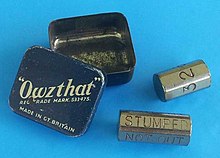I told him (in the comments), "One day - if you twist my arm very hard - I'll explain how I opened the batting for England against Australia"
Jim, who is never one to shirk a challenge, immediately took me up, replying, "I would LOVE to hear the story. Cricket, I assume"
So you see, it really is his fault that I am inflicting this cricketing tale on you.
I had quite forgotten about this story until I read Jim's post and I would have thought that it probably happened in the summer of 1954. That may well be the case, but I had also thought that the Australian cricket team were touring England whereas they were in England in the summer of 1953. But exactly when it happened is immaterial.
 At that time, it was possible to buy a game which I now find is spelt "Owzthat". The tin measures just over an inch on the longest side and contains two hexagonal dice. One is the batsman's die and the sides are numbered 1, 2, 3, 4, 6, and Owzthat. (I should perhaps explain that, in cricket, the fielding side appeals to the umpire by shouting, "How's that?") The second die is the umpire's and the sides are marked ‘bowled’, ‘caught’, ‘not out’, ‘stumped’, ‘L.B.W.’ (leg before wicket) and ‘no ball’.
At that time, it was possible to buy a game which I now find is spelt "Owzthat". The tin measures just over an inch on the longest side and contains two hexagonal dice. One is the batsman's die and the sides are numbered 1, 2, 3, 4, 6, and Owzthat. (I should perhaps explain that, in cricket, the fielding side appeals to the umpire by shouting, "How's that?") The second die is the umpire's and the sides are marked ‘bowled’, ‘caught’, ‘not out’, ‘stumped’, ‘L.B.W.’ (leg before wicket) and ‘no ball’.The batting side starts the game by rolling the batting die. Any runs signalled are recorded on the scorecard. When a 'owzthat' appeal is signalled, the umpire die is rolled for a decision. The batsman has a 1/3 chance of being not out, if the 'Not Out' or 'No Ball' is signalled. As in real cricket a 'No Ball' entitles the batsman to an additional strike (roll) and an extra run. A batsman is out if 'bowled', 'stumped', 'caught', or 'L.B.W.’ are signalled, and the next batsman comes to the crease. Depending on the cricket format the batting side is dismissed when all the batsmen are out or and if the over limit is reached. The other side then bats in an attempt to score more runs and hence win.
The game I remember was the one in which England (me) played Australia (can't remember who) and I opened the batting together with the now legendary Len Hutton. Among the other members of the England team were Peter May , Colin Cowdrey and (my favourite) Godfrey Evans.
I know that England won the real-life Ashes series of 1954-55, but just who won the match in which I played is a fact lost in the mists of time.
There are several Owzthat games for sale on Ebay with asking prices as high as £30 - but I don't think I will be tempted, although this was a very popular game 60 years ago.
You'd probably need to run those rules past me once (or twice) more ... My only cricketing claim to fame is rubbing shoulder with Viv Richards, Joel Garner (more rubbing my head on shoulders in their cases!) and Ian Botham in the 80's when they played for Somerset and used to go to the same clubs as me. Sadly, although I live within 5 minutes of the County ground I've never been inside it and have no clue how cricket works.
ReplyDeleteAnd I thought Suldog's rules were confusing.
ReplyDeleteI have heard that cricket is even slower than our baseball. Is that even possible?
Sarah, cricket is really quite simple. You have two teams, one in, the other out, and when all the team that is in are out, the team that was out goes in, although only two at a time, the rest staying in. Got that?
ReplyDeleteAnd Joe, test matches (internationals) can last five days, and county matches either three or four days, so yes, cricket is slower than baseball.